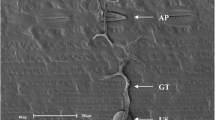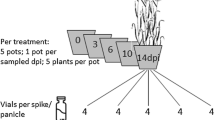Abstract
Patterns of infection withFusarium culmorum (W G Smith) Saccardo were observed in seedling roots of barley (Hordeum vulgare L.), wheat (Triticum aestivum L.), maize (Zea mays L.) and asparagus (Asparagus officinalis L). Apical regions of the main roots were not infected. Since penetration into the root occurred several days after inoculation and the roots were growing during the experiment, these regions had apparently not been in existence long enough to be infected. In older regions of barley, wheat and asparagus, hyphae entered through the tips of lateral roots. In barley and wheat, which had not developed any suberin lamellae in their subepidermal layer, infection occurred randomly over the remainder of the root. In maize, the fungus penetrated the epidermis at many sites but did not breach the exodermis in which all cells possessed both Casparian bands and suberin lamellae. Maize roots, therefore, sustained only minimal infections. In asparagus, the fungus grew through the short (passage) cells but never the long cells of the exodermis. In doing so, it penetrated cells possessing Casparian bands but lacking suberin lamellae. The results support the hypothesis that suberin lamellae provide effective barriers to the growth ofF. culmorum hyphae.
Similar content being viewed by others
References
BrammallR A and HigginsV J 1988 A histological comparison of fungal colonization in tomato seedlings susceptible or resistant toFusarium crown and root rot disease. Can. J. Bot. 66, 915–925.
BrundrettM C, KendrickB and PetersonC 1991 Efficient lipid staining in plant material with Sudan red 7B or Fluorol yellow 088 in polyethylene glycol-glycerol. Biotechnic Histochem. 66, 111–116.
BrundrettM C, PichéY and PetersonR L 1984 A new method for observing the morphology of vesicular-arbuscular mycorrhizae. Can. J. Bot. 62, 2128–2134.
FergusonI B and ClarksonD T 1975 Ion transport and endodermal suberization in the roots of corn. New Phytol. 75, 69–79.
GallaudI 1905 Etudes sur les mycorrhizes endophytes. Rev. Gén Bot. 17, 313–325.
Hussey R B 1982 Interactions between V-A mycorrhizal fungi andAsparagus officinalis L. roots. M Sc Thesis, University of Guelph, Guelph, ON, Canada.
Kamula S A 1991 The significance of suberin lamella development in the dimorphic exodermis. MSc Thesis, University of Waterloo, Waterloo, ON, Canada.
KolattukudyP E 1984 Fungal penetration of defensive barriers in plants.In Structure, Function and Biosynthesis of Plant Cell Walls. Eds. W MDugger and SBartnicki-Garcia. pp 302–343. American Society of Plant Physiologists, Rockland, MD.
KroemerK 1903 Wurzelhaut, Hypodermis und Endodermis der Angiospermenwurzel. Biblioth. Bot. 12, 1–159.
NoelleF W 1910 Studien zur vergleichenden Anatomie und Morphologie der Koniferen wurzeln mit Rücksicht auf die Systematik. Bot. Zeitung 68, 169–266.
PennypackerB W 1981 Anatomical changes involved in the pathogenesis of plants byFusarium.In Fusarium: Diseases, Biology, and Taxonomy. Eds. P ENelson, T AToussoun and R JCook. pp 400–408. Penn. State Univ. Press, University Park and London.
PerryJ W and EvertR F 1983 Histopathology ofVerticillium dahliae within mature roots of Russet Burbank potatoes. Can. J. Bot. 61, 3405–3421.
PerumallaC J and PetersonC A 1986 Deposition of Casparian bands and suberin lamellae in the exodermis and endodermis of young corn and onion roots. Can. J. Bot. 64, 1873–1878.
PerumallaC J, PetersonC A and EnstoneD E 1990 A survey of angiosperm species to detect hypodermal Casparian bands. I. Roots with a uniseriate hypodermis and epidermis. Bot. J. Linn. Soc. 103, 93–112.
PetersonC A, EmanuelM E and WilsonC 1982 Identification of a Casparian band in the hypodermis of onion and corn roots. Can. J. Bot. 60, 1529–1535.
PetersonC A and PerumallaC J 1990 A survey of angiosperm species to detect hypodermal Casparian bands. II. Roots with a multiseriate hypodermis or epidermis. Bot. J. Linn. Soc. 103, 113–125.
PetersonR L 1992 Adaptations of root structure in relation to biotic and abiotic factors. Can. J. Bot. 70, 661–675.
Shishkoff N 1986 The dimorphic hypodermis of plant roots: its distribution in the angiosperms, staining properties, and interaction with root-invading fungi. PhD Thesis, Cornell University, Ithaca, NY.
ShishkoffN 1987 Distribution of the dimorphic hypodermis of roots in angiosperm families. Ann. Bot. 60, 1–15.
SmithA K and PetersonR L 1985 Histochemical features of wall appositions inAsparagus root meristems infected byFusarium. Can. J. Plant Pathol. 7, 28–36.
Author information
Authors and Affiliations
Rights and permissions
About this article
Cite this article
Kamula, S.A., Peterson, C.A. & Mayfield, C.I. Impact of the exodermis on infection of roots byFusarium culmorum . Plant Soil 167, 121–126 (1994). https://doi.org/10.1007/BF01587606
Issue Date:
DOI: https://doi.org/10.1007/BF01587606




